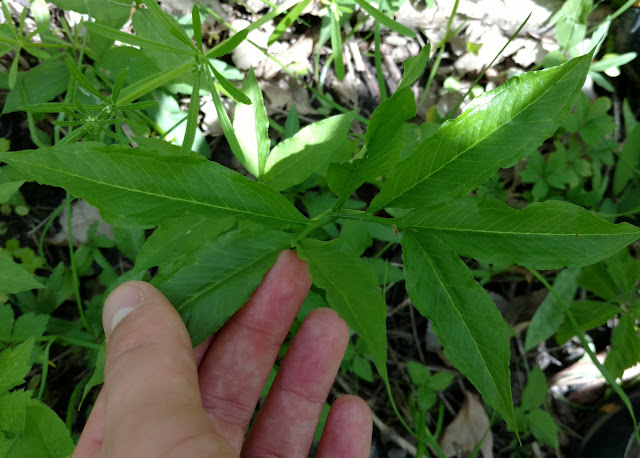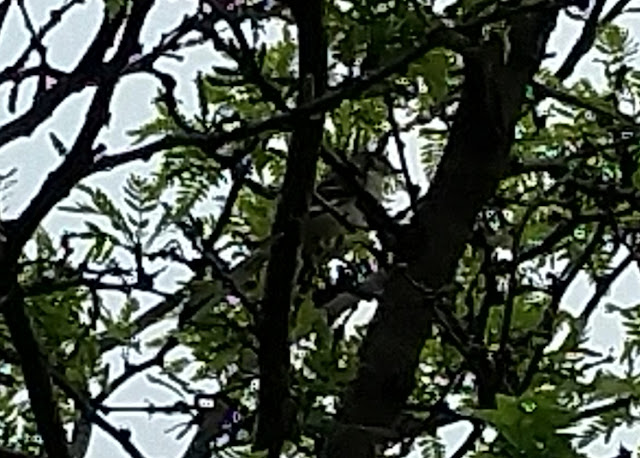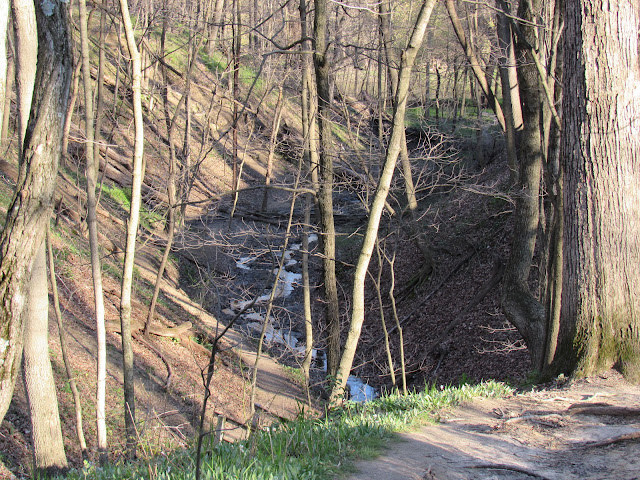Caution... This is a LONG post. I know some of you don't read everything, and just skim through the pictures, but you should be aware that I drained the power from two camera batteries in one day, and the results are below. I cut a LOT of pictures out of this.
Second Caution... Contains Snakes
Third Caution... Contains Insects. Of course, if you saw the Second Caution, you probably already left by now. Most people who hate bugs hate snakes as well.
A day like this requires something to kick it off, and a State-Endangered bird is an excellent way to do so. This Osprey (
Pandion haliaetus) flew over Lincoln Land Community College's pond today. This is the second Osprey I've seen this year, and indeed within the last two weeks. For all I know, it's probably the same bird, migrating north.
For once, I also got a good picture of the Pied-Billed Grebe (
Podilymbus podiceps), a bird which has cropped up in a large number of posts as of late. Yes, that is a Red-eared Slider behind the bird.
Oh, and I also visited the Bird Banding Station. This is a Dark-eyed Junco (
Junco hyemalis). a bird that indicates cool weather. I don't believe I've gotten such a good picture of a junco anywhere.
Speaking of good pictures, this Northern Watersnake (
Nerodia sipedon) decided to hang out nearby. Literally, it was hanging over a retaining wall above the pond. I got several pictures. A larger one was in the water under me as I leaned over to photograph this reptile. I don't have any problem with snakes, so that was fine by me. Later, I returned to the spot. Somebody else had arrived:
This Great Blue Heron (
Ardea herodias) is a frequent visitor to this pond, and you can see why. I don't know what kind of sunfish this bird is eating, but this is the first time I've had a camera ready when the bird gets a fish. This particular individual just watched placidly as I took pictures.
It was shaping up to be a great day already, and it became even more so when I saw my first-ever Spiny Softshell turtle (
Apalone spinifera) in the Lincoln Land pond. (The pond has a name, but I forget what it is.) This was a much bolder turtle than the Red-eared Sliders I normally see. It was willing to get within about seven feet of me, albeit with me on shore and it in the water. (By the way, I cannot tell the difference between Smooth and Spiny Softshells, but I know that the Smooth is much rarer in Illinois, except in the Sangamon River. I've seen both at one time or another.)
A nearby Song Sparrow (
Melospiza melodia) also got his picture taken, much to his surprise. (I know its a male because it was singing)
As usual, the mystery creature (There's one every post) has arrived. I've never seen this type of turtle before, and I thought it was a Snapping Turtle at the time. I've never seen one in the Lincoln Land pond before, so it's a red-letter Lincoln Land turtle day. Does anyone know what this is?
Moving on, I went to visit Carpenter Park Nature Preserve, a place fairly close to my house that I've never been to. I am currently having major regrets that I've never been here before. This is an Illinois Nature Preserve, the only one in Sangamon County. It deserves the title.
This is the first place I've ever seen female Stag Beetles in the wild. I need to look under more logs.
On top of the logs grew these colorful shelf fungi. Big downed logs were everywhere.
For the less than botanical, those plants that look kind of like unfolding umbrellas are Mayapples (Podophyllum peltatum), and I've never seen a larger number of these plants than I did here.
Speaking of things I've never seen before... Goldenseal (Hydrastis canadensis) is an extremely uncommon plant, though in this state it is not threatened or endangered. However, in most states, this plant is protected by law. Even in Illinois, there is a limit on the harvest of this plant, though in a nature preserve like Carpenter Park there is always an outright ban on collection of any species.
Part of the reason Goldenseal is so rare is that it is believed by many to be an herbal cure for... anything, really. Like acai. pomegranates, and many other "miracle cures" this poisonous plant is considered to be incredibly all-curing with little to no "scientific" evidence. Considering its rarity and toxicity, I think Goldenseal should be left alone for the botanist to get excited about.
Speaking of getting excited, an Eastern Garter Snake (
Thamnophis sirtalis) was discovered in a thicket near a grassland on the preserve...
...and so was this strange little moth, which landed on a member of our party and stayed about for a few minutes. This is the sort of insect I call a grass moth, which is not its actual name. It's just a designation for these little grey and/or brown moths that seem to be found in grassy areas.
Up in the trees, this Myrtle Warbler (Setophaga coronata ssp. coronata) jumped about. This is yet another species migrating to Canada eventually. It's a bit early for most warblers, which prefer to come when there are leaves on the trees. However, there are always the early birds.
After a bit, we made our way down into the bottomlands, where great trees grew. This is an old-growth forest, one of the few left along the Sangamon River. The trees are enormous.
The smaller trees in this area have been cleared before, so the area somewhat resembles a parkland.
Here's the Sangamon River. with an enormous dead tree in the midground.
Violets (Viola sororia), Spring Beauty (Claytonia virginica) and Woodland Phlox (Phlox divaricata) all flowered in a colorful grassy sandbar on the forest floor.
I've seen thousands of
Phlox flowers from over a dozen species, and this was the first time I ever found a
Phlox plant with a six-petaled flower. Usually, there's five petals.
A second "different" specimen of Phlox had extremely narrow petals. I've never seen anything quite like either of these phloxes before. I contemplated what would happen if they were introduced into the plant industry, but that would involve removing them from a nature preserve, which is illegal. So, nothing's going to happen on that front. Also, note the sand. Sand is an uncommon form of soil in Sangamon County, so large quantities of it are notable in their rarity.
Back to the trees. These trees... they may not look that big, but the only larger wild trees I've seen were growing in California, and they were called redwoods and sequoias. This Sycamore, the tree with the white bark, was easily a standout.
Here we are at the base of the tree, looking up. In case you hadn't figured it out, I like taking pictures from this angle. It's probably still hard to perceive how big this tree is.
Here we have a man who's six feet two inches tall at the base of this tree. Ok, get the picture now?
And now for something completely different... Buttercups (
Ranunculus spp.) grow commonly in these floodplain forests. You might recognize this plant from a previous post.
Here is a blogger in a tree.
What a rare sight to see!
Northern Cricket Frogs (
Acris crepitans) are the most common small frog species in Central Illinois.
Small creeks formed gaps in the slowly rising bluff line, forming a collection of microclimates.
Along the mouth of one of the creeks, Virginia Bluebells (
Mertensia virginica) had begun to bloom.
Here's an excellent example of the type of landform common along the edge of the river. Rolling bluffs and small ephemeral creeks meet in shallow but narrow valleys.
On the slopes of these valleys grew many plant species, including Bellwort (
Uvularia grandiflora)
Under a nearby log, a member of our group discovered this Dekay's Brown Snake (Storeria dekayi), which ought to be familiar by now as the most common woodland snake in central Illinois. I think I've set a personal record for finding this species of snake this year, with five, possibly six, so far.
Sandstone outcrops began appearing, and the top of the bluffs turned into a glade, with differing flora.
Some
Cystoptris ferns grew out of the rocky bank. Also known as Fragile Ferns, these are the most common fern species in Illinois, forming carpets of foliage in some areas.
This is a sandstone cliff. Wow. There are actually exposed rock outcroppings in Sangamon County. That is a rare sighting. Sincerely, Sangamon may not be the flattest county in Illinois, but it is close, and this is one of the few actual cliffs for miles.
Of course, on exposed sandstone outcroppings come particular plant species. This rocky-soil specialist, Sand Phlox (Phlox bifida) is a rare find in most parts of Illinois, and the same was true in Carpenter Park, where I saw it in only one location.
This ledge was a good thirty to forty feet above the river. Don't trip.
Here is an entire bluff covered in nothing but Fragile Ferns (
Cystopteris spp.) I was in heaven.

I couldn't resist.
Away from the river, we found this Jack-in-the-Pulpit (
Arisaema triphyllum), a species notable for having a colloquial name that I do not understand. I've been told many times how the spike in the middle (not visible in the picture) is supposed to resemble a preacher standing in his pulpit, but I do not see that at all
when I look at the flower.
I ventured down into the canyon nearby, trying to see if there were any orchids or rarer flowers.
Bellwort (
Uvularia grandiflora) grew on the steep, rocky sides of the ravine, the yellow flowers dangling over the edge as in the picture above.
I walked down to the canyon's floor. where a small stream snaked its way down towards the river. The creeks in Carpenter Park are so undisturbed that they have developed sandy beds and crystal-clear water. These streams eventually dry up in the summer when the rain slows.
Wild Stonecrop (
Sedum ternatum) was the last major discovery of the day. This is a plant I am far more familiar with in cultivation than in the wild. It appears that this plant, unlike most Sedum, prefers the shady moist cliffsides of wooded canyons. Of course it's not particular...
Yes, that is a piece of wood. An old bridge across the creek had apparently collapsed and been left alone for a few years. The Wild Stonecrop is growing on wood, with a thin veneer of dirt. The blurry brown spot, by the way, is a gnat that landed on my camera lens. After this, I departed from this wonderful place, exhausted by the trip but thankful for learning of such a wonderful nature preserve.
I did warn you it was going to be long.












